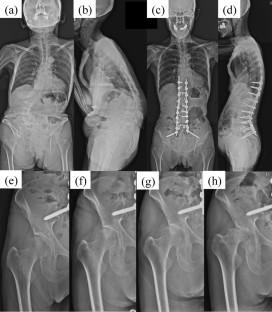European Spine Journal ( IF 2.6 ) Pub Date : 2022-08-23 , DOI: 10.1007/s00586-022-07344-2 Takuhei Kozaki 1 , Hiroshi Hashizume 1, 2 , Takaya Taniguchi 1 , Daisuke Nishiyama 1 , Hiroshi Iwasaki 1 , Shunji Tsutsui 1 , Masanari Takami 1 , Keiji Nagata 1 , Daisuke Fukui 1 , Manabu Yamanaka 1 , Hidenobu Tamai 1 , Ryo Taiji 1 , Shizumasa Murata 1 , Hiroyuki Oka 3 , Hiroshi Yamada 1

|
Purpose
This study aimed to evaluate the progression of hip pathology and risk factors after ASD surgery.
Methods
This case–control study enrolled 123 patients (246 hips); seven hips underwent hip arthroplasty were excluded. We measured the center-edge (CE) angle, joint space width (JSW), and Kellgren–Lawrence (KL) grade. We defined a CE angle˂25° as developmental dysplasia of the hip (DDH). We evaluated S2 alar-iliac (AI) screw loosening at final follow-up.
Results
The annual decrease in the JSW was 0.31 mm up to 1 year, and 0.13 mm after 1 year (p = 0.001). KL grade progression occurred in 24 hips (10.0%; group P), while no progression occurred in 215 (90.0%; group N) hips. Nonparametric analysis between groups P and N revealed that significant differences were observed in sex, DDH, KL grade, ratio of S2AI screw fixation at baseline, and ratio of S2AI screw loosening at final follow-up. Multiple logistic regression analysis revealed that DDH (p = 0.018, odds ratio (OR) = 3.0, 95%CI = 1.2–7.3), baseline KL grade (p < 0.0001, OR = 37.7, 95%CI = 7.0–203.2), and S2AI screw fixation (p = 0.035, OR = 3.4, 95%CI = 1.1–10.4) were significant factors. We performed sub-analysis to elucidate the relationship between screw loosening and hip osteoarthritis in 131 hips that underwent S2AI screw fixation. Non-loosening of the S2AI screw was a significant factor for KL grade progression (p < 0.0001, OR = 8.9, 95%CI = 3.0–26.4).
Conclusion
This study identified the prevalence and risk factors for the progression of hip osteoarthritis after ASD surgery. Physicians need to pay attention to the hip joint pathology after ASD surgery.
中文翻译:

S2 翼髂螺钉松动作为成人脊柱畸形手术后髋关节骨关节炎的预防因素:一项病例对照研究
目的
本研究旨在评估 ASD 手术后髋关节病理学的进展和危险因素。
方法
该病例对照研究纳入了 123 名患者(246 髋);7 个髋关节接受了髋关节置换术被排除在外。我们测量了中心边缘 (CE) 角、关节间隙宽度 (JSW) 和 Kellgren–Lawrence (KL) 等级。我们将 CE 角 25° 定义为髋关节发育不良 (DDH)。我们在最终随访时评估了 S2 翼-髂 (AI) 螺钉松动情况。
结果
JSW 在 1 年内每年减少 0.31 毫米,1 年后减少 0.13 毫米 ( p = 0.001)。24 髋(10.0%;P 组)出现 KL 级进展,而 215(90.0%;N 组)髋没有进展。P 组和 N 组之间的非参数分析显示,在性别、DDH、KL 分级、基线时 S2AI 螺钉固定率和最终随访时 S2AI 螺钉松动率方面观察到显着差异。多元逻辑回归分析显示 DDH(p = 0.018,比值比 (OR) = 3.0,95%CI = 1.2–7.3),基线 KL 等级(p < 0.0001,OR = 37.7,95%CI = 7.0–203.2),和 S2AI 螺钉固定 ( p = 0.035,OR = 3.4,95%CI = 1.1–10.4) 是重要因素。我们对 131 例接受 S2AI 螺钉固定的髋关节进行了亚组分析,以阐明螺钉松动与髋骨关节炎之间的关系。S2AI 螺钉未松动是 KL 分级进展的重要因素(p < 0.0001,OR = 8.9,95%CI = 3.0–26.4)。
结论
本研究确定了 ASD 手术后髋骨关节炎进展的患病率和危险因素。医师需要关注 ASD 手术后的髋关节病理。










































 京公网安备 11010802027423号
京公网安备 11010802027423号